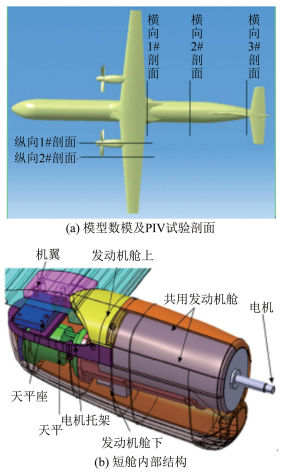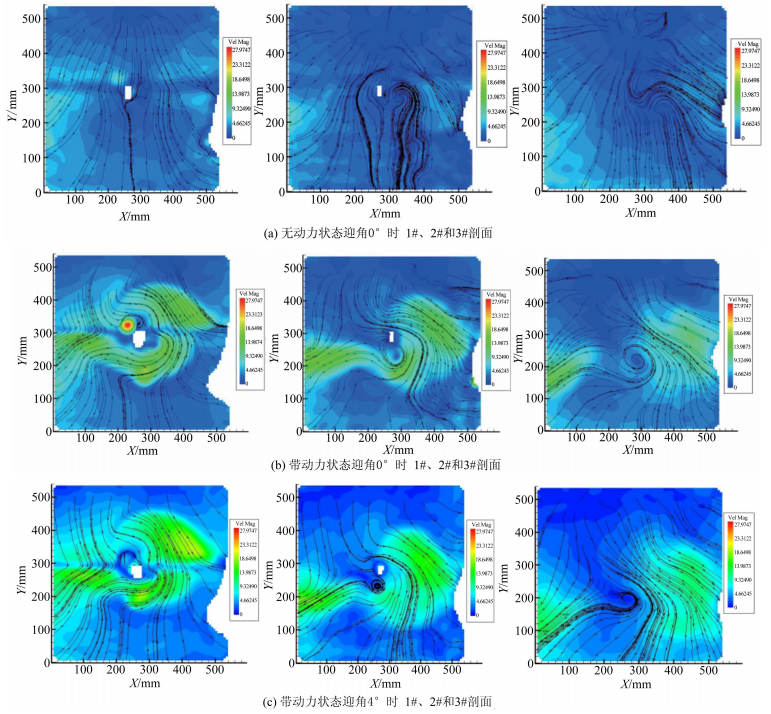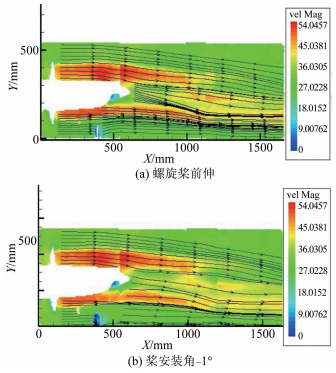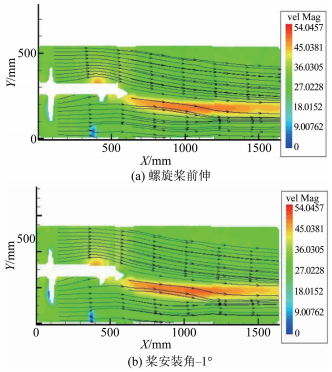Propeller slipstream effect on longitudinal aerodynamic characteristics of airplane
-
摘要: 采用螺旋桨飞机动力模拟风洞试验技术及粒子图像测速技术,研究双发常规布局涡桨飞机的螺旋桨滑流对飞机纵向气动特性的影响规律。通过测力风洞试验研究螺旋桨不同位置处滑流对飞机的升阻特性、力矩特性及平尾下洗等纵向气动特性的影响,利用PIV技术研究测力试验优选桨盘位置的飞机部件典型剖面受滑流影响时的流场变化情况。研究结果表明,螺旋桨下沉后滑流对飞机升阻特性的不利影响最明显,螺旋桨前伸和安装角由正变负时滑流对飞机的升阻特性均有改善,而螺旋桨前伸在飞机失速迎角附近对升力特性的改善更为明显。Abstract: Using the dynamic simulation and PIV test technology for propeller aircraft, research on the propeller slipstream effect on the longitudinal aerodynamic characteristics of the conventional layout twin-engined turboprop aircraft is conducted. Wind tunnel test is used to study the slipstream effect on longitudinal characteristics as the propeller position changes, such as the aircraft lift and drag characteristics, moment characteristics and horizontal tail downwash. PIV test is used to setting out typical section of aircraft components, mainly focus on the position conformed by slipstream wind tunnel test. Slipstream has bad effect especially on lift and drag characteristics when the propeller position sinkage. Both extending the propeller position forward and changing the propeller installation angle can improve the aerodynamic characteristics of the aircraft, while the aircraft lift characteristic is improved obviously especially around the stall angle when the propeller position extends forward.
-
Keywords:
- propeller slipstream effect /
- propeller position /
- wind tunnel test /
- PIV test
-
0 引 言
在直升机设计研究领域中,气动噪声问题已经成为一个重要的研究方向。尾桨和主旋翼是直升机气动噪声的主要来源,二者在噪声主要频率和指向性方面存在差异。尾桨气动噪声研究是直升机降噪设计研发的一个重要方面。涵道尾桨具有气动效率高、安全性好、噪声水平低等特点,在多种型号的直升机中得到应用,如法国的EC系列,美国的科曼奇,俄罗斯的卡–60,中国的直–9、直–19、AC312等机型[1-2]。涵道尾桨气动噪声特性与降噪设计研究有利于进一步改善直升机噪声水平,是直升机降噪设计研究领域中的重要方向之一。
欧美较早开展了涵道尾桨风洞试验研究,至20世纪90年代,相关风洞试验的硬件建设和技术能力都已达到比较成熟的水平,具备试验所需的消声室、声学风洞等设施,以及功能完善的试验台、测量设备与仪器、数据采集与处理系统等,为涵道尾桨气动噪声研究提供了手段。如法国CEPRA 19风洞具备0.88 m直径涵道尾桨气动噪声试验能力,以EC135直升机涵道尾桨为研究对象,开展了悬停、前飞状态下涵道尾桨气动噪声风洞试验测量,研究了尾桨叶片和定子叶片干扰噪声抑制方法[3-4]。欧洲直升机公司开展了涵道尾桨直升机飞行试验[5-6],获得了真实飞行条件下涵道尾桨直升机噪声特性,其中Blacodon等[6]针对海豚直升机开展的噪声源定位飞行试验结果表明,在2000~3000 Hz的中频范围内,涵道尾桨是主要的噪声源。NASA在其RAH66直升机研制期间,开展了涵道尾桨气动噪声研究[7-8],通过全尺寸地面试验台和风洞内缩比模型试验,研究了悬停、前飞状态下涵道尾桨的气动噪声特性。国外在涵道尾桨噪声计算和降噪设计方面开展了大量研究。如Roger等[9]对涵道尾桨噪声特性进行了理论和试验研究,通过计算和模型试验手段研究了涵道的反射、屏蔽作用。Pongratz等[10]在空客AGI声学试验室内开展了涵道尾桨悬停状态声学特性试验,研究了声衬式涵道内壁的降噪效果,试验表明采用声衬可实现约2 dB的降噪量。Riley等[11]研究发现表面涵道尾桨叶片非均匀分布可以有效降低涵道尾桨气动噪声。
国内早期关于直升机噪声的研究主要集中在旋翼气动噪声方面,对涵道尾桨噪声特性关注较少[12],仅开展了少量的噪声预测方法及试验测试技术等方面的研究。中国直升机设计研究所的仲唯贵等[13]以Farassat 1A公式进行了尾桨自由场噪声计算,采用边界元方法分析涵道的声学散射效应,形成了涵道尾桨气动噪声特性计算方法。在试验研究方面,仲唯贵等[1]在无来流试验条件下,以悬停状态为主,测量分析了涵道尾桨噪声辐射特性。目前国内鲜有公开发表的涵道尾桨声学风洞试验相关成果,对前飞状态下的噪声特性试验研究不足。
本文基于中国航空工业空气动力研究院 FL–52 航空声学风洞试验条件,开展涵道尾桨悬停、前飞状态下的噪声试验研究,分析噪声频谱及远场指向性等噪声特性,可为涵道尾桨降噪设计提供验证条件和数据参考。
1 涵道尾桨气动噪声风洞试验方法
1.1 FL–52风洞
FL–52风洞为单回路、开/闭口试验段两用的航空声学风洞,主要用于气动噪声产生机理及抑制方法研究、噪声计算技术验证等,其主要参数见表1。
表 1 FL–52风洞性能参数Table 1 The performance parameters of FL–52 wind tunnel参数 值 开/闭口试验段截面尺寸 2 m(宽) × 1.5 m(高) × 6.3 m(长) 试验段长度 6.3 m 开口试验段最大风速 100 m/s 闭口试验段最大风速 110 m/s 消声室尺寸 16 m(宽) × 11.5 m(高) × 15.5 m(长) 背景噪声 < 74.6 dB(A)
(开口试验段最大风速80 m/s时)1.2 试验模型
试验采用由中国航空工业空气动力研究院设计加工的金属涵道模型和复合材料尾桨模型。模型缩比为1∶1.5。如图1所示,Rotor1模型为叶片沿桨毂均匀布置构型,Rotor2模型为叶片非均匀布置构型,二者几何尺寸相同。试验模型主要参数如表2所示。
表 2 试验模型主要参数Table 2 Experimental model parameters参数 值 桨叶直径 0.667 m 桨叶数目 10 片 桨毂直径 0.27 m 桨尖与涵道间隙 3 mm 如图2所示,采用单桨支撑装置进行模型安装固定,模型置于试验段中心。以变频电机驱动涵道尾桨,可根据试验需求控制调节转速。
1.3 噪声测试系统
采用弧形阵列测量气动噪声的指向性,在消声室内的布置如图3所示。自由场选用电容麦克风B&K4954A(直径6.35 mm,动态范围40~159 dB)。使用7个麦克风进行测量,测量半径均为5 m。R1~R6麦克风与桨毂中心在同一水平面内,布置角度范围为80°~130°,角度间隔10°,R2麦克风位于尾桨拉力正前方(90°)。为避免来流影响,R7麦克风布置在风洞中轴线正下方桨盘旋转平面内,处于来流下游靠近收集器一侧,测点距桨毂中心5 m(水平方向距离4 m,垂直方向距离3 m),处于水平方位角180°处。
1.4 射流剪切层影响修正
与悬停状态不同,前飞状态下风洞内气动噪声试验须考虑射流剪切层影响。声波在穿过开口试验段的射流剪切层时会发生折射,导致由远场传声器测量得到的声波传播路径发生变化,使测点角度、传播距离均与无气流时不同,最终影响指向性曲线绘制。为了得到正确的声源角度和声压级,须对信号进行剪切层修正。基于Amiet理论对剪切层进行建模[14-15],假设它是无穷薄的涡流层且其两侧气流均匀,进而构建声折射的Snell定律:
$$ \frac{{c}_{{\rm{i}}}}{{\rm{cos}}{\theta }_{{\rm{r}}}}+v=\frac{{c}_{{\rm{a}}}}{{\rm{cos}}\theta } $$ (1) 式中:${c}_{{\rm{i}}}$、${c}_{{\rm{a}}}$分别为气流内部和外部声速,θ为折射角,$ {\theta }_{{\rm{r}}} $为修正角,v为开口试验段射流速度。结合传播路径之间的几何关系(如图4所示,其中t为传播时间),可以得出:
$$ {\rm{tan}}{\theta }_{{\rm{i}}}=\frac{\zeta }{{x}_{{\rm{m}}}+{(1+{x}_{{\rm{m}}})}^{2}{\rm{cos}}\theta } $$ (2) 式中:${\theta }_{{\rm{i}}}$为入射角,${{x}}_{{\rm{m}}}$为沿流场方向传声器与声源的距离,$\zeta =\sqrt{{(1-{x}_{{\rm{m}}}{\rm{cos}}\theta )}^{2}-{{\rm{cos}}}^{2}\theta }$。通过迭代求解,可以得到入射角${\theta }_{{\rm{i}}}$和折射角θ,进而得出修正角${\theta }_{{\rm{r}}}$。
以来流风速30 m/s为例,各测点修正角度见表3,可以看到,在80°~130°范围内,受剪切层影响的角度修正量均小于0.5°。这是因为剪切层对噪声传播路径的影响在上游表现得更加明显,试验监测的角度以下游为主,且来流风速较低,所以受射流剪切层影响较小。值得注意的是,如果开展高风速条件、0°~60°范围内的上游区域噪声试验研究,剪切层的影响将会更加突出,对指向性的影响也不可忽略。
表 3 来流风速30 m/s下剪切层修正角度Table 3 Correction results of jet shear layer at the velocity of 30 m/s麦克风 修正前角度 修正后角度 修正量 R1 80° 80.43° 0.43° R2 90° 90.36° 0.36° R3 100° 100.28° 0.28° R4 110° 110.18° 0.18° R5 120° 120.12° 0.12° R6 130° 130.07° 0.07° R7 180° 180.00° 0° 2 涵道尾桨噪声特性分析
2.1 悬停状态噪声特性分析
悬停状态试验模型为Rotor1(均匀桨叶)和Rotor2(非均匀桨叶),桨叶总距为20°、25°,试验转速为2400、2700、3000 r/min。
R2 麦克风测得的噪声频谱如图5~7所示(Lp为声压级)。表4给出了2种模型尾桨噪声频谱的若干典型频率声压级。可以看到, Rotor1模型噪声频谱中以桨叶通过频率500 Hz(轴频率50 Hz ×桨叶数目)最突出,声压级达70.9 dB,其整数倍频率(1000、1500 Hz)的离散噪声从低频向高频逐渐降低,其他宽频噪声幅值低于离散峰值20 dB以上。 Rotor2模型噪声频谱中10倍轴频率(500 Hz)不再是最突出成分,声压级仅为61.3 dB,离散峰值分散到轴频率的2、6、8、12倍等多个频率上,各频率之间声压级较为接近。这是由于均匀分布的桨叶通过频率是稳定的,与周围空气介质相互作用周期固定,其离散噪声以桨叶通过频率及其谐波频率为主。非均匀分布桨叶间的周向距离不相同,因此桨叶通过频率和流场均产生变化,导致离散噪声频率的改变。一般认为这种变化可以避免声能量在单一频段集中,分散到多个更低的频率,有利于降低人耳对该类噪声的感知[4]。
试验还测试了总距20°、25°悬停状态下的噪声特性,结果显示:总声压级随着总距的增大而升高,总距增大5°,总声压级升高约2 dB。对比分析图6和7可知:总距增大会导致桨叶通过频率(500 Hz)和其倍频上的离散噪声增大2~3 dB,但对宽频噪声影响较小。
试验测量了不同转速(2400、2700、3000 r/min,分别对应桨尖马赫数Ma1 = 0.246、Ma2 = 0.277、Ma3 = 0.308)悬停状态下的噪声特性,结果显示,总声压级随着转速的增大而升高。以90°测点(R2麦克风)为例,转速为2700和3000 r/min时,总声压级差量为–2.9 dB(接近10 lg(Ma2/Ma3)6 = –2.76),声功率与马赫数6次幂成正比,表明该状态下涵道尾桨噪声符合载荷噪声随马赫数变化的规律。
表 4 2种试验模型悬停状态典型频率对比Table 4 Typical frequency of two test models in hover频率/Hz 声压级/dB Rotor1 Rotor2 100 55.5 61.7 300 46.2 67.4 400 54.9 66.5 500 70.9 61.3 600 44.6 69.4 1000 65.2 48.5 1500 61.5 51.5 由图8所示的噪声指向性可见,在7.5倍桨盘直径(5 m)观测距离上,在80°~130°范围内(R1~R6),涵道尾桨悬停噪声总声压级除90°处略高以外,整体差异不明显,在旋转平面内(R7)降低约2~3 dB。
2.2 前飞状态噪声特性分析
前飞状态试验模型为Rotor1(均匀桨叶)和Rotor2(非均匀桨叶),桨叶总距为20°,试验转速为3000 r/min,来流风速为20、25、30 m/s。
前飞状态下,由于前行叶片和后行叶片速度不一致,同时也存在涵道和叶片在来流作用下形成的气动噪声,因此难以进行噪声和桨尖马赫数比例律分析。以均匀桨叶(Rotor1)为例,来流风速每增大5 m/s,噪声总声压级升高约2 dB。图9为Rotor1模型前飞状态下的噪声指向性,在80°~130°范围内,沿来流方向噪声水平无明显变化。在旋转平面内,180°测点(R7)噪声水平显著降低,声压级比其他测点低5~8 dB,远高于悬停状态下噪声差量。
从图10和11的噪声频谱中可见,前飞状态下宽频噪声占比明显增大,90°测点处,1000~3000 Hz频率范围内噪声水平达到60 dB,远高于悬停状态下的40~50 dB。相比之下,从90°测点处的噪声频谱中可以看到,桨叶通过频率(500 Hz)的离散噪声降低了约3 dB,1000 Hz以上宽频噪声降低了约10 dB,因此导致总声压级指向性变化明显。
3 结 论
依托FL–52航空声学风洞试验系统,开展了涵道尾桨气动噪声特性试验研究,主要结论如下:
1)涵道尾桨气动噪声频谱以桨叶通过频率的离散噪声为主,同时伴有宽频噪声,噪声水平随着尾桨的桨尖马赫数的增大而升高,悬停状态下涵道尾桨噪声符合载荷噪声马赫数比例律。
2)涵道对尾桨噪声的传播起到了明显的遮挡作用,涵道平面内噪声水平低于其他方向:悬停状态下,噪声降低约2 dB;前飞状态下降低更为明显,除离散噪声成分有3 dB的降低外,宽频噪声大幅降低约10 dB,总声压级降低约5~8 dB。
3)桨叶的非均匀布置会改变涵道尾桨的噪声频谱,使桨叶均匀分布时突出的单一频率噪声峰值变为数个水平接近的离散噪声,具有一定降噪潜力。
-
表 1 螺旋桨位置变化参数说明
Table 1 Propeller position parameters
序号 变化方向 螺旋桨位置变化范围 1 下沉 0mm,4.17mm,8.33mm 2 前伸 0mm,8.33mm,16.67mm 3 安装角 +1°,0°,-1° 表 2 螺旋桨不同位置处对平尾下洗角和下洗率的影响
Table 2 Influence of propeller position on horizontal tail downwash angle and slope
序号 桨盘位置 下洗角 下洗率 1 无桨 3.044 0.213 2 基准位置 3.104 0.228 3 前伸最大 3.045 0.193 4 下沉最大 3.219 0.209 5 安装角-1° 3.651 0.227 -
[1] Arne W. Stuermer. Validation of an unstructured chimera grid approach for the simulation of propeller flows[R]. AIAA-2004-5289, 2004.
[2] 杨小川, 王运涛, 王光学.螺旋桨非定常滑流的高效数值模拟研究[J].空气动力学学报, 2014, 32(3):290-294. http://www.cnki.com.cn/Article/CJFDTOTAL-KQDX201403003.htm Yang X C, Wang Y T, Wang G X. High efficiency numerical simulation of unsteady propeller slipstream[J]. Acta Aerodynamica Sinica, 2014, 32(3):290-294. http://www.cnki.com.cn/Article/CJFDTOTAL-KQDX201403003.htm
[3] 许和勇, 叶正寅.螺旋桨非定常滑流数值模拟[J].航空动力学报, 2011, 26(1):148-153. http://www.cnki.com.cn/Article/CJFDTOTAL-HKDI201101023.htm Xu H Y, Ye Z Y. Numerical simulation of unsteady propeller slipstream[J]. Journal of Aerospace Power, 2011, 26(1):148-153. http://www.cnki.com.cn/Article/CJFDTOTAL-HKDI201101023.htm
[4] Feng J. Computational analyses for an advanced propeller powered theater transport[R]. AIAA-2003-4081, 2003.
[5] Philipsen I, Hegen S. Advances in propeller simulation testing at the german-dutch wind tunnels (DNW)[R]. AIAA-2004-2502, 2004.
[6] Quennouz M, Shelleg N. Marianne aschwanden wind tunnel simulation of propeller effects in the A400M FLA-4 model[R]. AIAA-2005-3706, 2005.
[7] Eric W M. Roosenboom, Arne Stürmer. Comparison of PIV measurements with unsteady RANS cal-culations in a propeller slipstream[R]. AIAA-2009-3626, 2009.
[8] 刘沛清.空气螺旋桨理论及其应用[M].北京:北京航空航天大学出版社, 2006. Liu P Q. Research on air propeller theory and its application[M]. Beijing:BUAA Publishing Company, 2006.
[9] 范洁川.风洞试验手册[M].北京:航空工业出版社, 2002. Fan J C. Wind tunnel test references[M]. Beijing:Aerodynamic Industry Publishing Company, 2002.
[10] Cao Y H, Zhao M. Numerical simulation of rotor flow elds based on several spatiafi discretization schemes[J]. Journal of Aircraft, 2012, 49(5):2590-2600.
[11] Wu X H, Jean-Pierre H. Visualization of continuous stream of grid turbulence pastthe langston turbine cascade[R]. AIAA-2012-4847, 2012.
[12] Yin J P, Stuermer A. Aerodynamic and aeroacoustic analysis of installed pusher-propeller aircraft con gurationsfi[J]. Journal of Aircraft, 2012, 49(5):117-126. DOI: 10.2514/1.C031704






 下载:
下载:





















